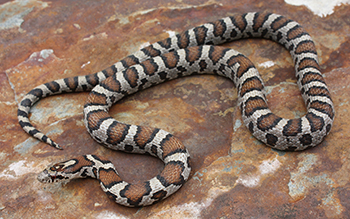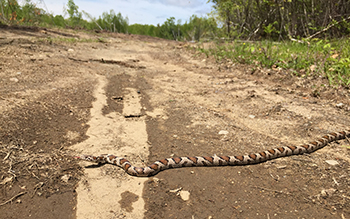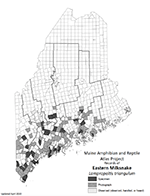Home → Fish & Wildlife → Wildlife → Species Information → Reptiles & Amphibians → Eastern Milksnake
Eastern Milksnake
Lampropeltis triangulum
On this page:

Photo: Trevor Persons
Distinguishing Characteristics
- Medium-sized, approximately 24 to 36 inches in length
- Light gray to tan above with black-bordered red, brown, or reddish-brown blotches
- Black-and-white checkerboard pattern below
- Smooth scales
- May be confused with juvenile North American racer
Status and Distribution in Maine
- Common and secure
- Southern and central regions
Habitat

Photo: Trevor Persons
- Found in forested uplands, brushy fields, meadows, grassland, old buildings, and rock outcrops
- Commonly found under rocks, logs, boards, and debris piles
Diet
- Primarily eats small mammals such as mice, voles, and shrews
Seasonal Changes
- Hibernates in old wells, stone walls, and rock crevices, and sometimes in attics and basements of homes
Natural History Notes
- Lays eggs in July under cover, or in loose substrate such as sawdust, manure, and sand
- Kills its prey by constriction
- Often found around farm buildings (origin of the myth that it suckles milk from cows), where it preys on abundant small mammals
- Vibrates tail when frightened, often confused with rattlesnakes
Share Your Sighting
There is much still to learn about the distribution and ecology of Maine’s herpetofauna, and we encourage members of the public to share their photo-documented observations as part of the Maine Amphibian & Reptile Atlas Project (MARAP).
To see if a township still needs documentation of a species, consult this distribution map (PDF). If a township lacks a photo or specimen record, we want your observation!
There are two ways to share your observations:
Submit your reptile or amphibian observation online
No service? No problem. Click here to download the survey to your device while connected, then take offline to collect observations from anywhere. Tip: The survey works best on Google Chrome and Safari.
Or upload sightings to the iNaturalist citizen science project through their website at iNaturalist.org or mobile app.
- When submitting an observation through iNaturalist add a description of the location (and other noteworthy information) to the “notes” field. This serves as a check on the locations automatically generated by smartphone cameras, which may be imprecise if cell service or GPS coverage is weak.
Thank you for doing your part to help conserve Maine’s reptiles and amphibians.
